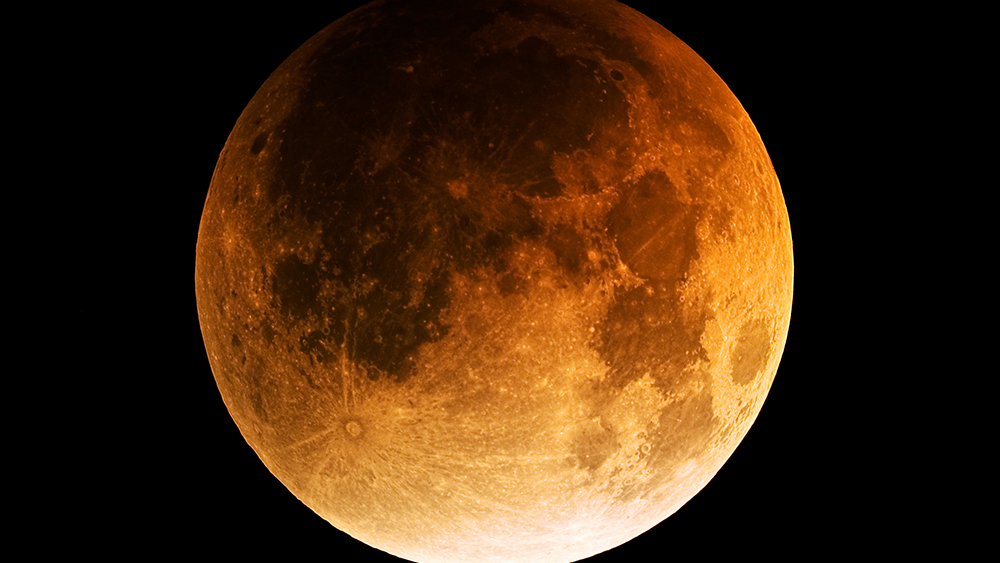On January 21, 2019, during a total lunar eclipse, astronomers and amateur stargazers alike saw a small meteorite strike the lunar surface.1 The collision was seen as a flash of light just before midnight Eastern Time. The darkened surface of the moon during the eclipse made the flash much easier to see. Although scientists have observed and recorded other meteorite strikes on the lunar surface, this is apparently the first time that observers witnessed a meteorite strike the moon during a total lunar eclipse.1,2
Besides being a potential first, this event is a reminder that meteorite impacts on the moon are much more common than secular scientists once thought. NASA’s Lunar Reconnaissance Orbiter (LRO) identified 222 new impact craters that formed during a seven year period—2009-2016. This is 33% more than researchers were expecting to find.3 This figure only included craters more than ten meters (around 32 feet) in diameter—the LRO could not see craters smaller than this. In that same seven year period, they found 47,000 new “splotches.” These splotches are changes in the shininess of the moon’s surface, resulting from secondary impacts of dust and rocks.4 These secondary impacts are craters formed from rocks and debris ejected from the original primary meteorite impact.
Secular scientists have long used lunar cratering rates to estimate the cratering rates for Mercury and Mars and other solar system bodies, after taking into account differences in size and gravity. These estimated rates are then used to infer ages for geological features on these solar system bodies.5
By 2006, however, secular scientists realized that there was a huge potential problem with this method. Researchers had been failing to recognize that many craters were likely the result of secondary, rather than primary, impacts.6 That realization raised the possibility that age estimates for geological features on Mars could be “off by orders of magnitude” (factors of 10 or greater)!7
Furthermore, this recent impact is a reminder of still another way that small lunar craters are problematic for old-earth ideology. The LRO detected scarps, or embankments, on the moon. Scientists think these scarps are caused by slight shrinkage of the moon’s still-cooling interior. These scarps often distort smaller craters as they form. Since small craters are thought to be relatively young, this means that the scarps are even younger. Secular scientists estimate that the scarps could be as young as 100 million years old, but no older than one billion years.8,9
This means that the scarps are quite young, even by secular reckoning. However, this contradicts previous claims made by secular scientists, who used to assert that the moon has been geologically dead for at least the last three billion years. Some secular websites still make this claim.10 Yet one secular scientist affiliated with the Smithsonian’s Air and Space Museum acknowledged that scarp formation might still be occurring even today.8 In that case, the moon would still be in the process of cooling off. This is far more consistent with a young moon than one that is billions of years old.
We expect to find more and more indications of youth in our solar system and beyond, consistent with God’s creation of the universe around 6,000 years ago. ![]()
Creation scientists aren’t surprised by these findings. As probes obtain more and more data, we expect to find more and more indications of youth in our solar system and beyond, consistent with God’s creation of the universe around 6,000 years ago.
References
1. Andrews, R. G. 2019. During the Lunar Eclipse, Something Slammed Into the Moon. New York Times. Posted on nytime.com on January 23, 2019, accessed January 31, 2019.
2. Bartels, M. 2019. Watch a Meteor Smack the Blood Moon in This Lunar Eclipse Video! Posted on space.com January 22, 2019, accessed January 31, 2019.
3. Witze, A. 2016. Meteorites pummel the Moon far more than expected. Nature. doi:10.1038/nature.2016.20777. Posted on nature.com on October 12, 2016, accessed January 31, 2019.
4. Boyle, R. The moon has hundreds more craters than we thought. Posted on newscientist.com on October 12, 2016, accessed January 31, 2019.
5. Fassett, C. I. 2016. Analysis of crater populations and the geochronology of planetary surfaces in the inner solar system. JGR Planets. 121 (10): 1900-1926.
6. Coppedge, D. F. 2007. Crisis in Crater Count Dating. Acts & Facts. 36 (1).
7. Kerr, R. A. 2006. Who Can Read the Martian Clock? Science. 312 (5777): 1132-1133.
8. Neal-Jones, N. and B. Steigerwald. August 19, 2010. Goddard Space Flight Center Press Release No. 10-072. NASA’s LRO Reveals ‘Incredible Shrinking Moon’. Posted on nasa.gov August 19, 2010, accessed January 31, 2019.
9. Walker, T. 2010. NASA pictures support biblical origin for moon. Journal of Creation. 24 (3): 8-10.
10. The Heat History of the Earth. Posted on csmgeo.csm.jmu.edu, accessed February 6, 2019.
Dr. Hebert is Research Associate at the Institute for Creation Research and earned his Ph.D. in physics from the University of Texas at Dallas.













